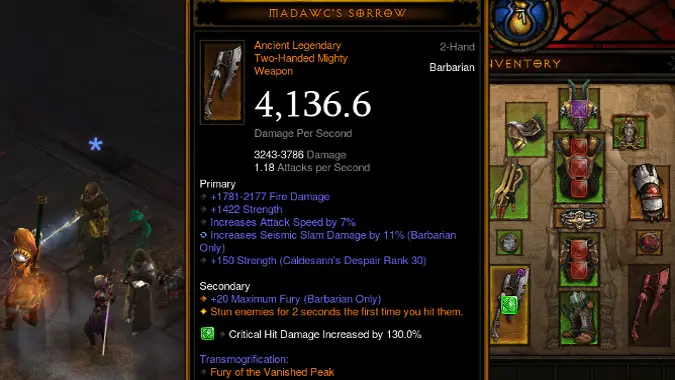Confused by gear in Diablo 3? Here’s what you need to know to gear up in Diablo
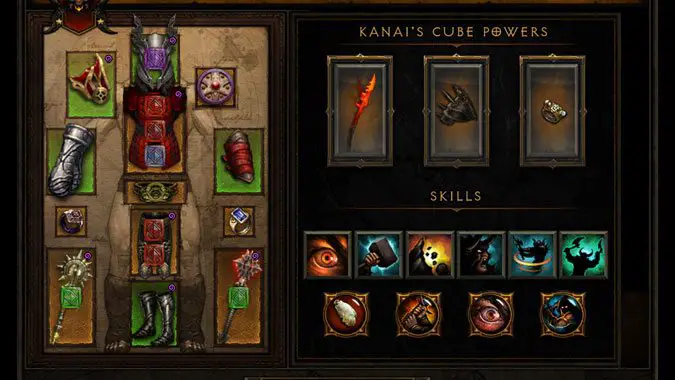
What makes an item in Diablo 3 good? This is the most basic gameplay issue, because Diablo 3 is a loot crawl action RPG, where half of the fun of slaughtering waves of abominations is the sweet, sweet treasure that rains from their destroyed bodies. How do we identify gear that’s good for us to use? What makes one piece of gear better for us than another piece?
While there’s a good deal of variation on the basics based on what class you’re playing — some weapon types are unique to a specific class, after all — there are still some basics worth keeping in mind.
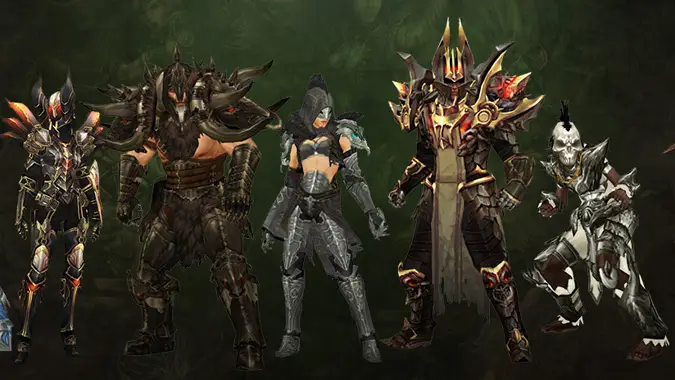
What do you wear and where?
Equipment comes in a wide variety of pieces, for a wide variety of armor slots. Though some armor pieces are unique to specific classes, as follows.
- Head: All classes can wear Helms and there are three special head armors — Spirit Stones for Monks, Wizard Hats for Wizards, and Voodoo Masks for Witch Doctors.
- Shoulder: All classes can wear Pauldrons.
- Torso: All classes can wear Chest Armor, and Demon Hunters can also wear Cloaks.
- Wrist: All classes can wear Bracers.
- Hand: All classes can wear Gloves.
- Waist: All classes can wear Belts, and Barbarians can also wear Mighty Belts
- Leg: All classes can wear Pants. Some don’t actually look like pants, but regardless, all classes can equip them.
- Feet: All classes can wear Boots.
- Jewelry: There’s one Amulet and two Ring slots for all characters.
- Off-hand: There are a great many off-hand items that are class specific. Shields are available to all classes, but Crusaders get their own, unique Crusader Shields, Witch Doctors use Mojos, Demon Hunters can equip Quivers, Wizards carry Orbs, and Necromancers use Phylacteries as off hand items.
Weapons, we have so many weapons
You may have noticed that the above list doesn’t include weapons. Weapons are a special case in that the most you can ever use is two of them, one in each hand, and some are two-handed. There are also ranged weapons that don’t actually count as either one- or two-handed. And it should be pointed out that even if a weapon isn’t restricted to a specific class, your class may not be able to use it — for example, Barbarians and Crusaders cannot use Staves, even though Staves aren’t restricted to specific classes. Likewise, while neither Barbarians nor Crusaders can use ranged weapons, Wizards theoretically can use bows and crossbows, although they almost never will.
Here are the weapons types you’ll encounter:
- One-handed weapons: Axes, Daggers, Maces, Spears, Swords, Ceremonial Knives (usable by Witch Doctors), Fist Weapons (usable by Monks), Flails (usable by Crusaders), Mighty Weapons (usable by Barbarians), and Scythes (usable by Necromancers).
- Two-handed weapons: Axes, Maces, Polearms, Staves, Swords, Daibo (usable by Monks), Flails (usable by Crusaders), Mighty Weapons (usable by Barbarians), and Scythes (usable by Necromancers).
- Ranged weapons: Bows, Crossbows, Wands (useable by Wizards), and Hand Crossbows (useable by Demon Hunters).
You can learn if your class of choice can use a specific weapon by going to the Official Diablo 3 site and putting a class filter over the results. But that doesn’t tell you what the various item qualities mean — so let’s take a look at what all of the information attached to these weapons means.
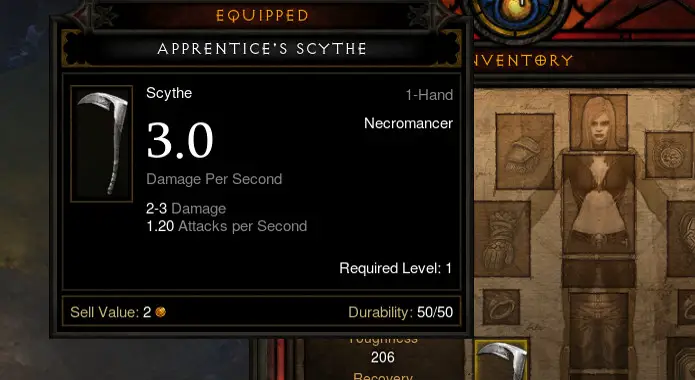
The rainbow of item quality
When you start out playing Diablo 3 or restart a new Season, the result is the same — your character begins with the most basic of gear. This gear is what we call Common quality, denoted in the game by white text. The Apprentice’s Scythe my Necromancer started with is a good example of Common quality items. They will continue to drop throughout the game as you level, but they are the bottom rung of the gearing ladder. A white item will usually be better than nothing but any other item quality will usually be an upgrade.
The next two qualities are fairly straightforward, there are Magic quality items, color coded blue, and Rare quality items, color coded yellow. Blue items are almost always superior to white items unless said common quality item is just many, many levels higher and if that happens you’ll almost certainly have a Magic drop first that will be better. Magic items also tend to enhance your stats in some way, like a bonus to XP gain or Thorns damage or what have you. Rare quality items are superior to Magic items and often have more enhancements to your stats than blues do.
The next two qualities are roughly at the same power level. Set items (also known as green quality items) and Legendary items (also called orange quality items) are considered the best gear available. Unlike Legendaries, which are powerful items in their own right, part of the power of a Set item is that when worn with other pieces of the same set it will grand a greater bonus. These Set Bonuses are often highly sought after because they can enhance a playstyle, as in the case of the Wrath of the Wastes set which buffs Rend and Whirlwind and rewards a Barbarian player who is using those two skills. Legendaries are more stand-alone items, such as the Burst of Wrath. You don’t need to wear more than one Legendary item to earn its benefits, making Legendaries slightly simpler to understand and use.
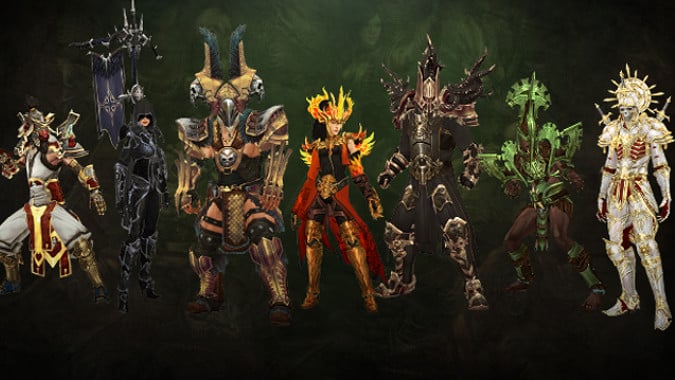
So what does it all mean?
Most sets tend to be armor pieces, but not all — there are weapon sets, ring sets, ring and amulet sets, and even sets that include armor pieces and weapons such as the Immortal King set. Both Set pieces and Legendaries have three variations. There are the standard Set and Legendary items, then Ancient Set and Ancient Legendary items which are stronger, and finally Primal Ancient pieces which are even better still. You will only find Primal Ancient pieces from solo Greater Rift 70 and above, which Ancient Set and Ancient Legendary pieces have a chance to drop on Torment I and a higher chance on higher Torment difficulties.
To break it all down for you:
- Given equivalent levels, Orange and Green items are the best, followed by yellow, followed by blue, and last white, which is the worst quality gear. However, a yellow or blue item that is significantly higher level (a level 67 yellow vs a level 30 Legendary) will sometimes be an upgrade.
- Even a white quality item is better than nothing — if you have nothing in a slot, go ahead and put that white on. Otherwise, vendor it for gold or dismantle it for crafting materials.
- The best way to get items is to kill monsters. That’s where they drop. Also remember to smash as many containers and open as many chests as possible, because they can also contain gold and loot.
- We wrote a guide to treasure goblins a while back, but they’re still a great source for loot, so here it is again.
And that wraps up how gear works in Diablo 3. In general, you always want the best gear available — as you level up, a blue quality piece might beat your Legendary, if it’s a high enough level upgrade. Always pay attention to the DPS on weapon drops, the armor value on armor pieces, and the stats on rings and amulets.
Next time we’ll talk about the various difficulty levels in Diablo 3 and what they mean for you.
Please consider supporting our Patreon!
Join the Discussion
Blizzard Watch is a safe space for all readers. By leaving comments on this site you agree to follow our commenting and community guidelines.
 @MatthewWRossi
@MatthewWRossi